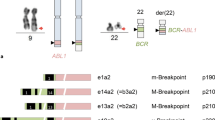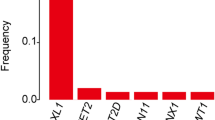Abstract
Constitutive activation of protein tyrosine kinases plays a central role in the pathogenesis of myeloproliferative disorders, including BCR-ABL-negative chronic myeloid leukemia. Current research is focused on elucidating the full spectrum of causative mutations in this rare, heterogeneous disease. Activated tyrosine kinases are excellent targets for signal transduction therapy, and an accurate diagnosis including morphology, karyotyping, and molecular genetics will become increasingly important to direct individualized treatment. In addition, new molecular findings need to be incorporated into disease classification systems.
Similar content being viewed by others
References and Recommended Reading
Vardiman JW, Harris NL, Brunning RD: The World Health Organization (WHO) classification of the myeloid neoplasms. Blood 2002, 100:2292–2302.
Chase A, Huntly BJ, Cross NCP: Cytogenetics of chronic myeloid leukaemia. Best Pract Res Clin Haematol 2001, 14:553–571.
Onida F, Ball G, Kantarjian HM, et al.: Characteristics and outcome of patients with Philadelphia chromosome negative, bcr/abl negative chronic myelogenous leukemia. Cancer 2002, 95:1673–1684.
Steer EJ, Cross NCP: Myeloproliferative disorders with translocations of chromosome 5q31-35: role of the platelet-derived growth factor receptor-β. Acta Haematol 2002, 107:113–122.
Baxter EJ, Hochhaus A, Bolufer P, et al.: The t(4;22)(q12;q11) in atypical chronic myeloid leukaemia fuses BCR to PDGFRA. Hum Mol Genet 2002, 11:1391–1397.
Trempat P, Villalva C, Laurent G, et al.: Chronic myeloproliferative disorders with rearrangement of the platelet-derived growth factor alpha receptor: A new clinical target for STI571/Glivec. Oncogene 2003, 22:5702–5706.
Cools J, DeAngelo DJ, Gotlib J, et al.: A tyrosine kinase created by fusion of the PDGFRA and FIP1L1 genes as a therapeutic target of imatinib in idiopathic hypereosinophilic syndrome. N Engl J Med 2003, 348:1201–1214.
Griffin JH, Leung J, Bruner RJ, et al.: Discovery of a fusion kinase in EOL-1 cells and idiopathic hypereosinophilic syndrome. Proc Natl Acad Sci U S A 2003, 100:7830–7835.
Score J, Curtis C, Waghorn K, et al.: Identification of a novel imatinib responsive KIF5B-PDGFRA fusion gene following screening for PDGFRA overexpression in patients with hypereosinophilia. Leukemia 2006, 20:827–832.
Pardanani A, Ketterling RP, Li CY, et al.: FIP1L1-PDGFRA in eosinophilic disorders: prevalence in routine clinical practice, long-term experience with imatinib therapy, and a critical review of the literature. Leuk Res 2006, 30:965–970.
Walz C, Curtis C, Schnittger S, et al.: Transient response to imatinib in a chronic eosinophilic leukemia associated with ins(9;4)(q33;q12q25) and a CDK5RAP2-PDGFRA fusion gene. Genes Chromosomes Cancer 2006, 45:950–956.
Stover EH, Chen J, Folens C, et al.: Activation of FIP1L1-PDGFRα requires disruption of the juxtamembrane domain of PDGFRα and is FIP1L1-independent. Proc Natl Acad Sci U S A 2006, 103:8078–8083.
Wilkinson K, Velloso ER, Lopes LF, et al.: Cloning of the t(1;5)(q23;q33) in a myeloproliferative disorder associated with eosinophilia: involvement of PDGFRB and response to imatinib. Blood 2003, 102:4187–4190.
Morerio C, Acquila M, Rosanda C, et al.: HCMOGT-1 is a novel fusion partner to PDGFRB in juvenile myelomonocytic leukemia with t(5;17)(q33;p11.2). Cancer Res 2004, 64:2649–2651.
Vizmanos JL, Novo FJ, Román JP, et al.: NIN, a gene encoding a CEP110-like centrosomal protein, is fused to PDGFRB in a patient with a t(5;14)(q33;q24) and an imatinib-responsive myeloproliferative disorder. Cancer Res 2004, 64:2673–2676.
Levine RL, Wadleigh M, Sternberg DW, et al.: KIAA1509 is a novel PDGFRB fusion partner in imatinib-responsive myeloproliferative disease associated with a t(5;14)(q33;q32). Leukemia 2005, 19:27–30.
Grand FH, Burgstaller S, Kuhr T, et al.: p53-Binding protein 1 is fused to the platelet-derived growth factor receptor beta in a patient with a t(5;15)(q33;q22) and an imatinib-responsive eosinophilic myeloproliferative disorder. Cancer Res 2004, 64:7216–7219.
Rosati R, La Starza R, Luciano L, et al.: TPM3/PDGFRB fusion transcript and its reciprocal in chronic eosinophilic leukaemia. Leukemia 2006, 20:1623–1624.
Abe A, Emi N, Tanimoto M, et al.: Fusion of the platelet-derived growth factor receptor beta to a novel gene CEV14 in acute myelogenous leukemia after clonal evolution. Blood 1997, 90:4271–4277.
David M, Cross NCP, Burgstaller S, et al.: Durable responses to imatinib in patients with PDGFRB fusion gene-positive and BCR-ABL -negative chronic myeloproliferative disorders. Blood 2007, 109:61–64.
Gotlib J: Molecular classification and pathogenesis of eosinophilic disorders: 2005 update. Acta Haematol 2005, 114:7–25.
Vannier JP, Bizet M, Bastard C, et al.: Simultaneous occurrence of a T-cell lymphoma and a chronic myelogenous leukemia with an unusual karyotype. Leuk Res 1984, 8:647–657.
Macdonald D, Reiter A, Cross NCP: The 8p11 myeloproliferative syndrome: a distinct clinical entity caused by constitutive activation of FGFR1 [review]. Acta Haematol 2002, 107:101–107.
Inhorn RC, Aster JC, Roach SA, et al.: A syndrome of lymphoblastic lymphoma, eosinophilia, and myeloid hyperplasia/malignancy associated with t(8;13)(p11;q11): description of a distinctive clinicopathologic entity. Blood 1995, 85:1881–1887.
Guasch G, Popovici C, Mugneret F, et al.: Endogenous retroviral sequence is fused to FGFR1 kinase in the 8p12 stem-cell myeloproliferative disorder with t(8;19)(p12;q13.3). Blood 2003, 101:286–288.
Belloni E, Trubia M, Gasparini P, et al.: 8p11 myeloproliferative syndrome with a novel t(7;8) translocation leading to fusion of the FGFR1 and TIF1 genes. Genes Chromosomes Cancer 2005, 42:320–325.
Grand EK, Grand FH, Chase AJ, et al.: Identification of a novel gene, FGFR1OP2, fused to FGFR1 in the 8p11 myeloproliferative syndrome. Genes Chromosomes Cancer 2003, 40:78–83.
Walz C, Chase A, Schoch C, et al.: The t(8;17)(p11;q23) in the 8p11 myeloproliferative syndrome fuses MYO18A to FGFR1. Leukemia 2005, 19:1005–1009.
Demiroglu A, Steer EJ, Heath C, et al.: The t(8;22) in chronic myeloid leukemia fuses BCR to FGFR1 : transforming activity and specific inhibition of FGFR1 fusion proteins. Blood 2001, 98:3778–3783.
Vizmanos JL, Hernandez R, Vidal MJ, et al.: Clinical variability of patients with the t(6;8)(q27;p12) and FGFR1OP-FGFR1 fusion: two further cases. Hematol J 2004, 5:534–537.
Roumiantsev S, Krause DS, Neumann CA, et al.: Distinct stem cell myeloproliferative/T lymphoma syndromes induced by ZNF198-FGFR1 and BCR-FGFR1 fusion genes from 8p11 translocations. Cancer Cell 2004, 5:287–298.
Lin P, Jones D, Medeiros LJ, et al.: Activating FLT3 mutations are detectable in chronic and blast phase of chronic myeloproliferative disorders other than chronic myeloid leukemia. Am J Clin Pathol 2006, 126:530–533.
Vu HA, Xinh PT, Masuda M, et al.: FLT3 is fused to ETV6 in a myeloproliferative disorder with hypereosinophilia and a t(12;13)(p13;q12) translocation. Leukemia 2006, 20:1414–1421.
Lacronique V, Boureux A, Valle VD, et al.: A TEL-JAK2 fusion protein with constitutive kinase activity in human leukemia. Science 1997, 278:1309–1312.
Peeters P, Raynaud SD, Cools J, et al.: Fusion of TEL, the ETS-variant gene 6 (ETV6), to the receptor-associated kinase JAK2 as a result of t(9;12) in a lymphoid and t(9;15;12) in a myeloid leukemia. Blood 1997, 90:2535–2540.
Reiter A, Walz C, Watmore A, et al.: The t(8;9)(p22;p24) is a recurrent abnormality in chronic and acute leukemia that fuses PCM1 to JAK2. Cancer Res 2005, 65:2662–2667.
Griesinger F, Hennig H, Hillmer F, et al.: A BCR-JAK2 fusion gene as the result of a t(9;22)(p24;q11.2) translocation in a patient with a clinically typical chronic myeloid leukemia. Genes Chromosomes Cancer 2005, 44:329–333.
Ries LAG, Eisner MP, Kosary CL: SEER Cancer Statistic Review, 1975–2000. Bethesda, MD: National Cancer Institute; 2003.
Jones AV, Kreil S, Zoi K, et al.: Widespread occurrence of the JAK2 V617F mutation in chronic myeloproliferative disorders. Blood 2005, 106:2162–2168.
Steensma DP, Dewald GW, Lasho TL, et al.: The JAK2 V617F activating tyrosine kinase mutation is an infrequent event in both “atypical” myeloproliferative disorders and myelodysplastic syndromes. Blood 2005, 106:1207–1209.
Jelinek J, Oki Y, Gharibyan V, et al.: JAK2 mutation 1849G>T is rare in acute leukemias but can be found in CMML, Philadelphia chromosome-negative CML, and megakaryocytic leukemia. Blood 2005, 106:3370–3373.
Gu TL, Goss VL, Reeves C, et al.: Phosphotyrosine profiling identifies the KG-1 cell line as a model for the study of FGFR1 fusions in acute myeloid leukemia. Blood 2006, 108:4202–4204.
Kurzrock R, Bueso-Ramos CE, Kantarjian H, et al.: BCR rearrangement-negative chronic myelogenous leukemia revisited. J Clin Oncol 2001, 19:2915–2926.
Chen J, DeAngelo DJ, Kutok JL, et al.: PKC412 inhibits the zinc finger 198-fibroblast growth factor receptor 1 fusion tyrosine kinase and is active in treatment of stem cell myeloproliferative disorder. Proc Natl Acad Sci U S A 2004, 101:14479–14484.
Talpaz M, Shah NP, Kantarjian H, et al.: Dasatinib in imatinib-resistant Philadelphia chromosome-positive leukemias. N Engl J Med 2006, 354:2531–2541.
Kantarjian H, Giles F, Wunderle L, et al.: Nilotinib in imatinib-resistant CML and Philadelphia chromosome-positive ALL. N Engl J Med 2006, 354:2542–2551.
Stover EH, Chen J, Lee BH, et al.: The small molecule tyrosine kinase inhibitor AMN107 inhibits TEL-PDGFRβ and FIP1L1-PDGFRα in vitro and in vivo. Blood 2005, 106:3206–3213.
Lierman E, Folens C, Stover EH, et al.: Sorafenib (BAY 43-9006) is a potent inhibitor of FIP1L1-PDGFRA and the imatinib resistant FIP1L1-PDGFRA T674I mutant. Blood 2006, 108:1374–1376.
Tefferi A, Gilliland G: Classification of chronic myeloid disorders: From Dameshek towards a semi-molecular system. Best Pract Res Clin Haematol 2006, 19:365–385.
Author information
Authors and Affiliations
Corresponding author
Rights and permissions
About this article
Cite this article
Burgstaller, S., Reiter, A. & Cross, N.C.P. BCR-ABL-negative chronic myeloid leukemia. Curr Hematol Malig Rep 2, 75–82 (2007). https://doi.org/10.1007/s11899-007-0011-5
Published:
Issue Date:
DOI: https://doi.org/10.1007/s11899-007-0011-5




